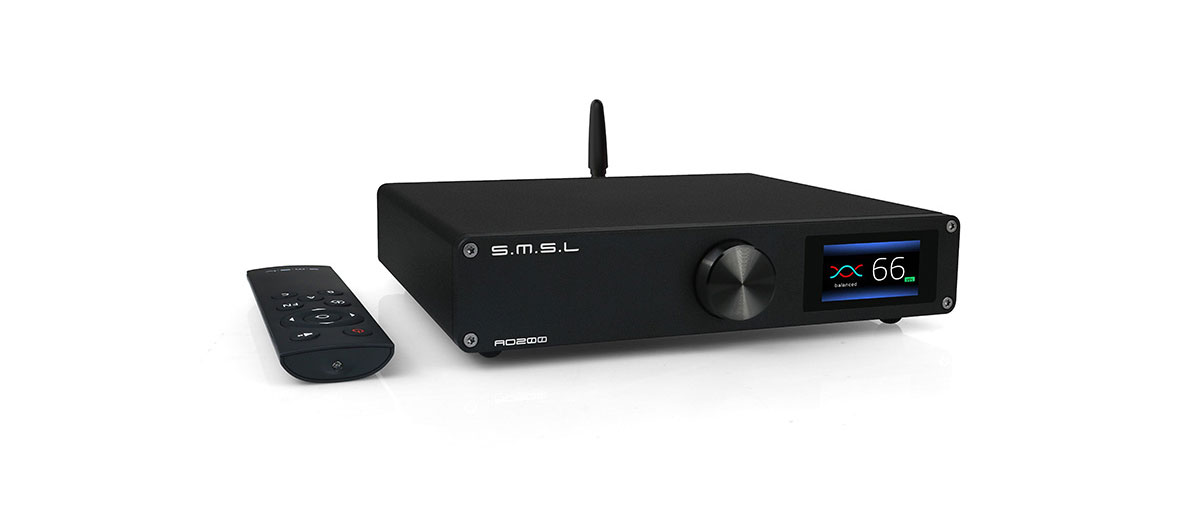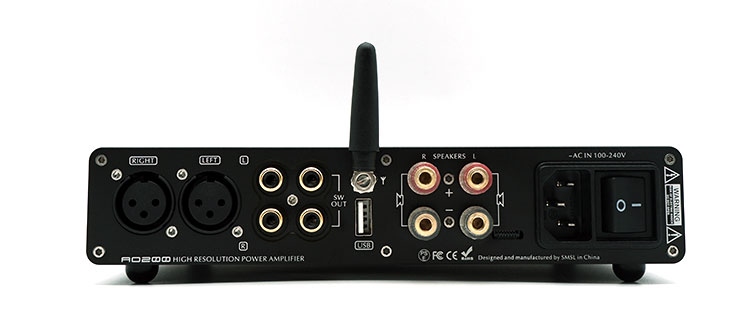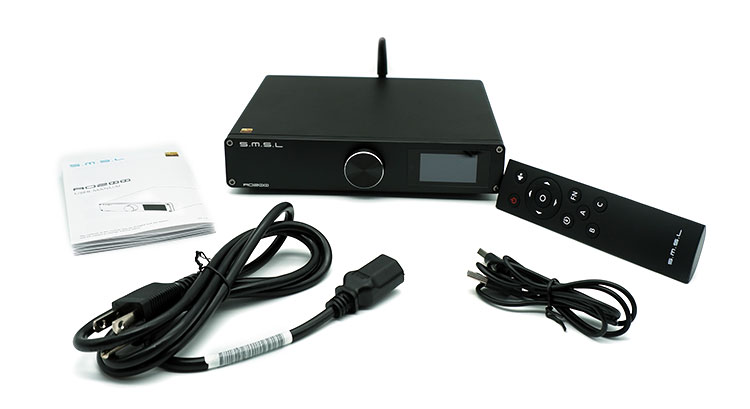The SMSL AO200 is a compact power amplifier with a Bluetooth Wireless receiver and up to 90W of output power into a 4Ω load. It is priced at $279.
Disclaimer: The SMSL AO200 was sent to us as a sample in exchange for our honest opinion in this review. We thank Aoshida Audio and SMSL for this opportunity.
To learn more about SMSL reviews on Headfonics you can click here.
Note, this 2-page review follows our new scoring guidelines for 2021 which you can read up on here.
SMSL has traditionally been a company that focuses on DACs, and headphone amps. However, they have recently released more high-performance 2 channel audio gear.
Just a few months ago, SMSL released their DA-9, which is a class-D amplifier that is designed to be triple stacked with the SU-9 and SH-9. And then in the last month, SMSL also released an integrated amplifier with the same specifications, and is advertised as class D. This is the AO200, which is released in cooperation with Aoshida Audio, maybe that’s why its model name is AO?

Tech Highlights
When you look at the specs sheet of the AO200, it shows that it has the makings of a high-quality stereo integrated amplifier. It features an NJW1194 volume control chip to ensure channel balance. The rest of the components are also high-quality components with ERO audio capacitors and low noise MELF resistors.
Aside from these components, the AO200 also features a high-quality Class D amplifier chip in the Infineon MA12070, with 2 of those chips configured in a full balanced topology inside the chassis.
These MA12070 use the MERUS technology, which allows the 4 MOSFETS to generate a PWM signal with 3 states instead of just 2 in traditional class D, and this smoothens the output signal of the amplifier.
Design
The entire chassis of the AO200 is made of aluminum, which is CNC milled to properly fit the components inside. Being aluminum, it can also serve as a heat sink, which will be more than enough for the normally cool class D operation of the amplifier.
When I was looking up the AO200 online, I was imagining that it would be small and light. Although it’s not exactly a full rack-sized amplifier, it’s heavier and a bit wider than the other SMSL components that I’ve handled recently.
Right in the middle of the front fascia of the amplifier, is the volume knob. The right side of the front fascia features a 1.9” TFT screen that shows the status of the amplifier and will assist with menu navigation.
Underneath the AO200, 4 sturdy rubber feet keep the AO200 firmly on my audio rack. This is a welcome addition since it would prevent thicker cables from pulling on the smaller AO200.
Input/Output
For a small integrated amplifier, the AO200 has a lot of input options. Located at the rear of the device, the input options include the standard single-ended and balanced analog input, as well Bluetooth, and an option to directly plug in a computer via the USB A to USB A cable, or a USB flash drive. And finally, there is an IEC power inlet on the far right of the device.
The output on the other hand is straightforward. It just features 1 pair of 5-way bind posts for speaker termination and a pair of subwoofer outputs. The arrangement of the binding posts is in a tight square formation, and I honestly would have wanted to see a more spaced-out arrangement of the speaker terminals to make termination with bare wire or spade connectors a bit quicker.
Adding in a subwoofer to the mix is easy with the AO200, as the sub outs will just follow the volume level of the main speaker terminals. Unfortunately, there isn’t any control over the cutoff frequency of the subwoofer out, so an active subwoofer with control over its cutoff frequency will make integration much easier.
USB port
The USB port on the AO200 has 2 functions. The first one is what I originally expected it to be, and it’s using a flash drive to plug into the device. The caveat is that the USB port will only allow MP3 files to be played, also it will just play the files on an infinite loop, and there aren’t options for the next track, pause, or previous track.
The 2nd functionality of the USB port is as an input from a computer or phone. The connection is done with the supplied USB A to USB A cable. I was surprised that my laptop immediately detected it as a DAC. So when I played music, the music started playing through the AO200.
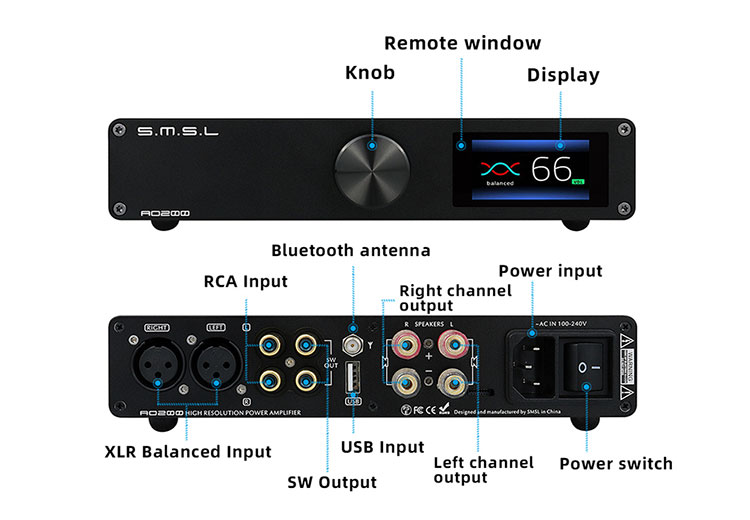
Interface
Primarily, there are 2 ways to interact with the AO200. The first is directly interacting with the device using the volume knob.
Here selections can be made by pressing on the volume knob. Pressing and holding the knob, on the other hand, will make it go to the previous menu, and then turning the volume knob would allow the user to change the volume and scroll through the selection.
The 2nd way to interact with the AO200 is using the remote control. The remote control that came with the AO200 is the standard remote that comes with most of SMSL’s other DACs. To use the remote control, first click on the A button for “amplifier”, then start pressing the buttons on the menu which will allow the user access to the menu, input selection, and volume adjustment.
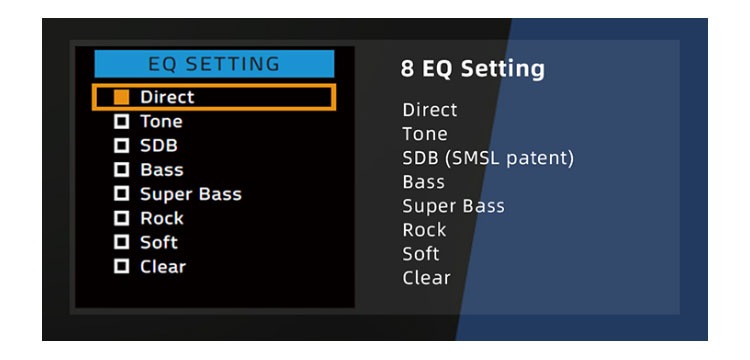
SDB Sound
By default, the AO200 arrives in direct mode, and of course, this is the stock tonality of the amplifier. In addition to that, there is the SDB option, Tone, Bass, Super Bass, Rock, Soft, and Clear.
Bass, Super Bass, Rock, Soft, and Clear are options that mainly modify the tone of the amplifier to have a fixed adjustment as described.
The more interesting tonality options are in SDB and Tone. SDB is like a loudness button on most other amplifiers, where it follows a version of a Fletcher-Munsen curve compensation where bass and treble are boosted at lower volumes, and proportionately decreased as the volume is increased. This allows for a perceived consistent tonality throughout the different volumes.
Tone on the other hand simply allows the user to customize the tonality of the amplifier based on their preference by adjusting bass and treble. The frequency around which the bass and treble adjustments are centered isn’t stated in the manual or the documentation though.
Bluetooth Connectivity
The AO200 is equipped with Bluetooth 5.0, but it’s only limited to SBC/AAC Bluetooth transmission. Although this might be a limiting factor at times, the clarity of the signal through Bluetooth is acceptable.
When I’m walking around my dining room with my phone, the Bluetooth signal from my phone to the AO200 remains stable. It’s only when I move to another room, around 5 meters away with a thick 9” wall is between my phone and the AO200, will the signal start to just stutter and degrade.
Packaging & Accessories
The AO200 arrives in a box that is standard with most SMSL products, however, the box that the AO200 arrives in is a little bigger than the usual box that SMSL’s other products such as the SU-9/SH-9 stack. Inside, it’s lined with thick foam that ensures that the amplifier is kept safe during transport and storage.
Aside from the amplifier, the box also contains a remote control, the power cable, the Bluetooth antenna, a USB A to USB A cable, and the manuals. I would have wanted to see some RCA cables, but I believe the Bluetooth antenna and the USB A cable will work just fine to get the system up and running immediately.
Sound Impressions
Bass
The most prominent trait of the AO200 is that it has an agile presentation. With the bass, there is a prominent, and immediate sense of attack. What detracts from the experience though is that the bass will tend to lack some sustain, so bass guitars won’t be as flowy, and instead, each note would end up having a more distinct character.
Mids
Going into the midrange, vocal tracks particularly for those sung in the bass or baritone frequency range end up sounding euphonic. However, going into the tenor range makes the voices a bit more subdued, and colder. Although vocals end up a bit dry, particularly in the upper midrange, the vocal texture is easy to pick out.
The presentation of instruments in the midrange is done well, with guitars and pianos exhibiting a good sense of body and weight. The attack of each keystroke on the piano is immediate, but it may lack some bloom and sparkle, something that I’ve come to expect from other amps.
Treble
The treble presentation is crystalline, where cymbal hits are distinct from each other. I would have wanted to hear a bit more shimmer though. Going up into the air frequencies, the AO200 has a good amount of upper treble extension, so room information is easily relayed.
Staging
Due to the more agile character of the AO200, it has a good sense of image separation, and the placement of the images within the soundstage is accurate.
There is a good amount of layering within the soundstage, however, the images play within a smaller area, so they tend to crowd together a bit. Overall, the size of the soundstage is respectable, and the size of the images is natural, however, I would have wanted to hear a more layered soundstage.
When it comes to dynamic range, the AO200’s slightly larger power supply gives a bit more power to back up those crescendos. Playing softer tends to be a bit more difficult with the AO200 though.
Click on page 2 for synergy and select comparisons

